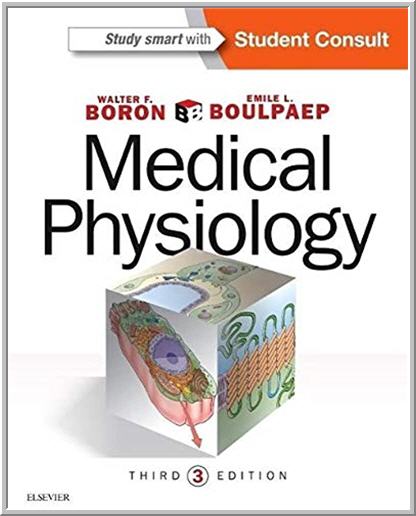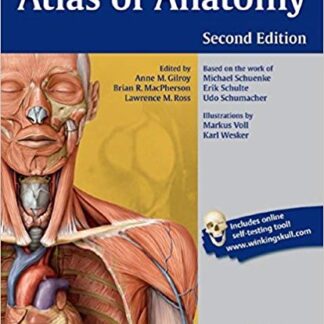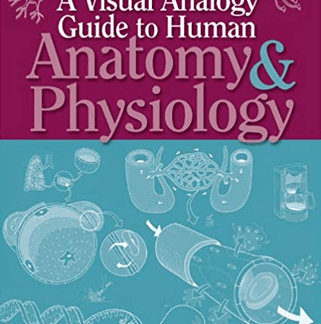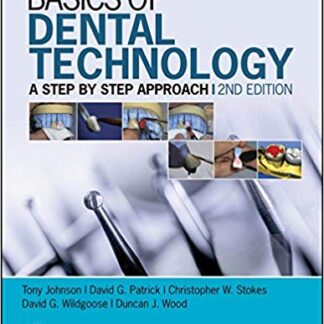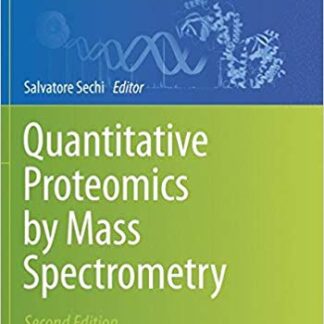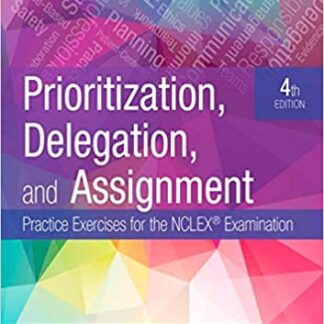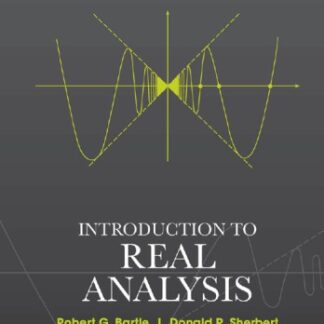Description
Medical Physiology 3rd Edition by Walter F. Boron, ISBN-13: 978-1455743773
[PDF eBook eTextbook]
- Publisher: Elsevier; 3rd edition (May 19, 2016)
- Language: English
- 1312 pages
- ISBN-10: 1455743771
- ISBN-13: 978-1455743773
For a comprehensive understanding of human physiology ― from molecules to systems ―turn to the latest edition of Medical Physiology. This updated textbook is known for its unparalleled depth of information, equipping students with a solid foundation for a future in medicine and healthcare, and providing clinical and research professionals with a reliable go-to reference. Complex concepts are presented in a clear, concise, and logically organized format to further facilitate understanding and retention.
- Clear, didactic illustrations visually present processes in a clear, concise manner that is easy to understand.
- Intuitive organization and consistent writing style facilitates navigation and comprehension.
- Takes a strong molecular and cellular approach that relates these concepts to human physiology and disease.
- An increased number of clinical correlations provides a better understanding of the practical applications of physiology in medicine.
- Highlights new breakthroughs in molecular and cellular processes, such as the role of epigenetics, necroptosis, and ion channels in physiologic processes, to give insights into human development, growth, and disease.
- Several new authors offer fresh perspectives in many key sections of the text, and meticulous editing makes this multi-authored resource read with one unified voice.
Table of Contents:
Cover image
Title Page
Table of Contents
Copyright
Contributors
Video Table of Contents
Preface to the Third Edition
The eBook
Acknowledgments
Preface to the First Edition
Target Audience
Content of the Textbook
Emphasis of the Textbook
Creating the Textbook
Special Features
Acknowledgments
Section I Introduction
Chapter 1 Foundations of Physiology
References
Section II Physiology of Cells and Molecules
Chapter 2 Functional Organization of the Cell
Structure of Biological Membranes
Function of Membrane Proteins
Cellular Organelles and the Cytoskeleton
Synthesis and Recycling of Membrane Proteins
Specialized Cell Types
References
Chapter 3 Signal Transduction
Mechanisms of Cellular Communication
Receptors That are Ion Channels
Receptors Coupled to G Proteins
Receptors That are Catalytic
Nuclear Receptors
References
Chapter 4 Regulation of Gene Expression
From Genes to Proteins
The Promoter and Regulatory Elements
Transcription Factors
Regulation of Inducible Gene Expression by Signal-Transduction Pathways
Epigenetic Regulation of Gene Expression
Post-Translational Regulation of Gene Expression
References
Glossary
Chapter 5 Transport of Solutes and Water
The Intracellular and Extracellular Fluids
Solute Transport Across Cell Membranes
Regulation of Intracellular Ion Concentrations
Water Transport and the Regulation of Cell Volume
Transport of Solutes and Water Across Epithelia
References
Chapter 6 Electrophysiology of the Cell Membrane
Ionic Basis of Membrane Potentials
Electrical Model of a Cell Membrane
Molecular Physiology of Ion Channels
References
Chapter 7 Electrical Excitability and Action Potentials
Mechanisms of Nerve and Muscle Action Potentials
Physiology of Voltage-Gated Channels and Their Relatives
Propagation of Action Potentials
References
Chapter 8 Synaptic Transmission and the Neuromuscular Junction
Mechanisms of Synaptic Transmission
Synaptic Transmission at the Neuromuscular Junction
Toxins and Drugs Affecting Synaptic Transmission
References
Chapter 9 Cellular Physiology of Skeletal, Cardiac, and Smooth Muscle
Skeletal Muscle
Cardiac Muscle
Smooth Muscle
Diversity among Muscles
References
Section III The Nervous System
Chapter 10 Organization of the Nervous System
Cells of the Nervous System
Development of Neurons and Glial Cells
Subdivisions of the Nervous System
References
Chapter 11 The Neuronal Microenvironment
Cerebrospinal Fluid
Brain Extracellular Space
The Blood-Brain Barrier
Glial Cells
References
Chapter 12 Physiology of Neurons
Signal Conduction in Dendrites
Control of Spiking Patterns in the Soma
Axonal Conduction
References
Chapter 13 Synaptic Transmission in the Nervous System
Neuronal Synapses
Neurotransmitter Systems of the Brain
Reference
Fast Amino Acid–Mediated Synapses in the CNS
Plasticity of Central Synapses
References
Chapter 14 The Autonomic Nervous System
Organization of the Visceral Control System
Reference
Synaptic Physiology of the Autonomic Nervous System
References
Central Nervous System Control of the Viscera
Reference
References
Chapter 15 Sensory Transduction
Chemoreception
Visual Transduction
References:
Vestibular and Auditory Transduction: Hair Cells
Somatic Sensory Receptors, Proprioception, and Pain
References
Chapter 16 Circuits of the Central Nervous System
Elements of Neural Circuits
Simple, Stereotyped Responses: Spinal Reflex Circuits
Rhythmic Activity: Central Pattern Generators
Spatial Representations: Sensory and Motor Maps in the Brain
Temporal Representations: Time-Measuring Circuits
References
Section IV The Cardiovascular System
Chapter 17 Organization of the Cardiovascular System
Elements of the Cardiovascular System
Hemodynamics
How Blood Flows
Origins of Pressure in the Circulation
How to Measure Blood Pressure, Blood Flow, and Cardiac Volumes
References
Chapter 18 Blood
Blood Composition
Blood Viscosity
Hemostasis and Fibrinolysis
References
Chapter 19 Arteries and Veins
Arterial Distribution and Venous Collection Systems
Elastic Properties of Blood Vessels
References
Chapter 20 The Microcirculation
Capillary Exchange of Solutes
References
Capillary Exchange of Water
Reference
References
Lymphatics
Regulation of the Microcirculation
References
Chapter 21 Cardiac Electrophysiology and the Electrocardiogram
Electrophysiology of Cardiac Cells
The Electrocardiogram
Cardiac Arrhythmias
References
Chapter 22 The Heart as a Pump
The Cardiac Cycle
Cardiac Dynamics
From Contractile Filaments to a Regulated Pump
References
Chapter 23 Regulation of Arterial Pressure and Cardiac Output
Short-Term Regulation of Arterial Pressure
Regulation of Cardiac Output
Matching of Venous Return and Cardiac Output
Intermediate- and Long-Term Control of the Circulation
References
Chapter 24 Special Circulations
The Brain
The Heart
The Skeletal Muscle
The Splanchnic Organs
The Skin
References
Chapter 25 Integrated Control of the Cardiovascular System
Interaction among the Different Cardiovascular Control Systems
Response to Erect Posture
Responses to Acute Emotional Stress
Response to Exercise
Response to Hemorrhage
References
Section V The Respiratory System
Chapter 26 Organization of the Respiratory System
Comparative Physiology of Respiration
Organization of the Respiratory System in Humans
Lung Volumes and Capacities
References
Chapter 27 Mechanics of Ventilation
Static Properties of the Lung
Dynamic Properties of the Lung
References
Chapter 28 Acid-Base Physiology
pH and Buffers
Acid-Base Chemistry When Is the Only Buffer
Acid-Base Chemistry in the Presence of and Buffers—The Davenport Diagram
pH Regulation of Intracellular Fluid
References
Chapter 29 Transport of Oxygen and Carbon Dioxide in the Blood
Carriage of O2
Carriage of CO2
References
Chapter 30 Gas Exchange in the Lungs
Diffusion of Gases
Diffusion and Perfusion Limitations on Gas Transport
References
Chapter 31 Ventilation and Perfusion of the Lungs
Ventilation
Perfusion of the Lung
Matching Ventilation and Perfusion
References
Chapter 32 Control of Ventilation
Overview of the Respiratory Control System
Neurons That Control Ventilation
Generation of the Respiratory Rhythm
Chemical Control of Ventilation
Modulation of Ventilatory Control
References
Section VI The Urinary System
Chapter 33 Organization of the Urinary System
Functional Anatomy of the Kidney
References
Main Elements of Renal Function
Reference
Measuring Renal Clearance and Transport
The Ureters and Bladder
References
Chapter 34 Glomerular Filtration and Renal Blood Flow
Glomerular Filtration
Renal Blood Flow
Control of Renal Blood Flow and Glomerular Filtration
References
Chapter 35 Transport of Sodium and Chloride
Na+ and Cl− Transport by Different Segments of The Nephron
Na+ and Cl−, and Water Transport at the Cellular and Molecular Level
Regulation of Na+ and Cl− Transport
References
Chapter 36 Transport of Urea, Glucose, Phosphate, Calcium, Magnesium, and Organic Solutes
Urea
Glucose
Other Organic Solutes
Phosphate
Calcium
Magnesium
References
Chapter 37 Transport of Potassium
Potassium Balance and the Overall Renal Handling of Potassium
Potassium Transport by Different Segments of the Nephron
Potassium Transport at the Cellular and Molecular Levels
Regulation of Renal Potassium Excretion
References
Chapter 38 Urine Concentration and Dilution
Water Balance and the Overall Renal Handling of Water
Water Transport by Different Segments of the Nephron
Generation of a Hyperosmotic Medulla and Urine
Regulation by Arginine Vasopressin
References
Chapter 39 Transport of Acids and Bases
Acid-Base Balance and the Overall Renal Handling of Acid
Acid-Base Transport by Different Segments of the Nephron
Acid-Base Transport at the Cellular and Molecular Levels
Regulation of Renal Acid Secretion
References
Chapter 40 Integration of Salt and Water Balance
Control of Extracellular Fluid Volume
Control of Water Content (Extracellular Osmolality)
References
Section VII The Gastrointestinal System
Chapter 41 Organization of the Gastrointestinal System
Overview of Digestive Processes
Regulation of Gastrointestinal Function
Gastrointestinal Motility
Reference
References
Chapter 42 Gastric Function
Functional Anatomy of the Stomach
Acid Secretion
Pepsinogen Secretion
Protection of the Gastric Surface Epithelium and Neutralization of Acid in the Duodenum
Filling and Emptying of the Stomach
References
Chapter 43 Pancreatic and Salivary Glands
Overview of Exocrine Gland Physiology
Pancreatic Acinar Cell
Pancreatic Duct Cell
Composition, Function, and Control of Pancreatic Secretion
Salivary Acinar Cell
Salivary Duct Cell
Composition, Function, and Control of Salivary Secretion
References
Chapter 44 Intestinal Fluid and Electrolyte Movement
Functional Anatomy
Overview of Fluid and Electrolyte Movement in the Intestines
Cellular Mechanisms of Na+ Absorption
Cellular Mechanisms of Cl− Absorption and Secretion
Cellular Mechanisms of K+ Absorption and Secretion
Regulation of Intestinal Ion Transport
References
Chapter 45 Nutrient Digestion and Absorption
Carbohydrate Digestion
Carbohydrate Absorption
Protein Digestion
Protein, Peptide, and Amino-Acid Absorption
Lipid Digestion
Lipid Absorption
Digestion and Absorption of Vitamins and Minerals
Nutritional Requirements
References
Chapter 46 Hepatobiliary Function
Overview of Liver Physiology
Functional Anatomy of the Liver and Biliary Tree
Uptake, Processing, and Secretion of Compounds by Hepatocytes
Bile Formation
Enterohepatic Circulation of Bile Acids
The Liver as a Metabolic Organ
References
Section VIII The Endocrine System
Chapter 47 Organization of Endocrine Control
Principles of Endocrine Function
Peptide Hormones
Amine Hormones
Steroid and Thyroid Hormones
References
Chapter 48 Endocrine Regulation of Growth and Body Mass
Growth Hormone
Growth-Promoting Hormones
Regulation of Body Mass
References
Chapter 49 The Thyroid Gland
Synthesis of Thyroid Hormones
Action of Thyroid Hormones
Hypothalamic-Pituitary-Thyroid Axis
References
Chapter 50 The Adrenal Gland
The Adrenal Cortex: Cortisol
The Adrenal Cortex: Aldosterone
The Adrenal Medulla
References
Chapter 51 The Endocrine Pancreas
Insulin
Glucagon
Somatostatin
References
Chapter 52 The Parathyroid Glands and Vitamin D
Calcium and Phosphate Balance
Physiology of Bone
Parathyroid Hormone
Vitamin D
Calcitonin and Other Hormones
References
Section IX The Reproductive System
Chapter 53 Sexual Differentiation
Genetic Aspects of Sexual Differentiation
Differentiation of the Gonads
Development of the Accessory Sex Organs
Differentiation of the External Genitalia
Endocrine and Paracrine Control of Sexual Differentiation
Puberty
References
Chapter 54 The Male Reproductive System
Hypothalamic-Pituitary-Gonadal Axis
Testosterone
Biology of Spermatogenesis and Semen
Male Sex Act
References
Chapter 55 The Female Reproductive System
Hypothalamic-Pituitary-Gonadal Axis and Control of the Menstrual Cycle
Ovarian Steroids
The Ovarian Cycle: Folliculogenesis, Ovulation, and Formation of the Corpus Luteum
The Endometrial Cycle
Female Sex Act
Menopause
References
Chapter 56 Fertilization, Pregnancy, and Lactation
Transport of Gametes and Fertilization
Implantation of the Developing Embryo
Physiology of the Placenta
The Maternal-Placental-Fetal Unit
Response of the Mother to Pregnancy
Parturition
Lactation
References
Chapter 57 Fetal and Neonatal Physiology
Biology of Fetal Growth
Development and Maturation of the Cardiopulmonary System
Cardiopulmonary Adjustments at Birth
Neonatal Physiology
References
Section X Physiology of Everyday Life
Chapter 58 Metabolism
Forms of Energy
Energy Balance
Energy Interconversion From Cycling between 6-Carbon and 3-Carbon Molecules
Energy Capture (Anabolism)
Energy Liberation (Catabolism)
Integrative Metabolism During Fasting
References
Chapter 59 Regulation of Body Temperature
Heat and Temperature: Advantages of Homeothermy
Modes of Heat Transfer
Active Regulation of Body Temperature by the Central Nervous System
Hypothermia, Hyperthermia, and Fever
References
Chapter 60 Exercise Physiology and Sports Science
Motor Units and Muscle Function
Conversion of Chemical Energy to Mechanical Work
Muscle Fatigue
Determinants of Maximal O2 Uptake and Consumption
Sweating
Endurance (Aerobic) Training
References
Chapter 61 Environmental Physiology
The Environment
Diving Physiology
High-Altitude Physiology
Flight and Space Physiology
References
Chapter 62 The Physiology of Aging
Concepts in Aging
Cellular and Molecular Mechanisms of Aging
Aging of the Human Physiological Systems
Aging Slowly
References
Index
What makes us different?
• Instant Download
• Always Competitive Pricing
• 100% Privacy
• FREE Sample Available
• 24-7 LIVE Customer Support

